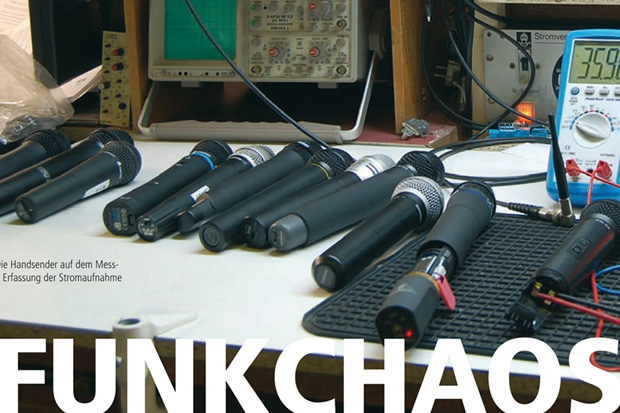WS 1000& WS 1616 – Wireless Chaos Part 2 – Test Report by tools4music

LD Systems WS -1000
790.850 – 813.800 MHz = 22.95 MHz frequency bandwidth
The receiver is installed in a 9.5″ metal housing and is powered by a separate power adapter. While the two antennas are screwed onto the rear panel, the front panel impresses with a clearly organised, highly legible display. Additional LED meters indicate the field strengths of the two diversity channels. Another LED meter shows the audio level of the input signal. The WS-1000 MC handheld transmitter, which is contained in a metal housing, features a condenser capsule. The rubberised grip with it recessed display is worthy of special mention in terms of equipment, as is the channel selection which is set on the receiver and synchronised with the handheld transmitter via an infrared interface. Power is supplied by two 1.5V AA batteries, the charge status of which is visible on the receiver. The system comes in a sturdy plastic carrying case with space for all of the necessary components. LD Systems also offers an “X” version of the WS-1000 system for the higher 838.850 to 861.800 MHz frequency band.
Evaluation
This system is a pleasure to use: Just pre-select the frequency on the receiver, start the infrared transmission, and the handheld transmitter is ready for operation. LD Systems states that it is possible to operate up to eight systems simultaneously, which should not be a problem given a bandwidth of nearly 23 MHZ. The power consumption of the handheld transmitter is a mere 64 mA. The display uses three bars to indicate when the 2.4V, 2V, and 1.5V levels have been reached. The transmission only weakened after twelve hours and at a range of 130 meters – impressive figures in this field of candidates. The microphone housing impressed with high-quality workmanship, low susceptibility to feedback, and minimal handling noise, whereby the treble response of the capsule was somewhat subdued. If this is not to your liking, you can unscrew the capsule and replace it, for example, with a dynamic microphone capsule from LD Systems. The design with the screw threads and the three contact springs is strongly reminiscent of the proven Shure replaceable head system.
 Another test winner. The WS-1000 shares its place on the winner’s rostrum with the PU-910 by dBTechnologies.
Another test winner. The WS-1000 shares its place on the winner’s rostrum with the PU-910 by dBTechnologies.
LD Systems WS-1616 „Sweet Sixteen“
863 – 865 MHz = 2 MHz frequency bandwidth
The WS-1616 system by LD Systems makes a very sturdy impression, for the WS-1616 R receiver comes in a 9.5″ metal housing with antennas screwed onto the rear panel. The front panel contains a four-element LED meter for the audio level and two additional LEDs for the status of the two diversity channels. A two-character digital display assists in channel selection using two buttons; as in the LD Systems WS-1000, transmission to the WS-1616MD handheld transmitter takes place via an infrared interface. The handheld transmitter is also contained in a metal housing with a rubberised grip and a metal microphone grille. As with many of the microphones tested, power is provided by two 1.5V type AA batteries. There is an on/off switch on the end of the microphone; LD Systems has not provided a mute switch. The entire set comes in a carrying case identical to the one supplied with the LD Systems WS-1000.
Evaluation
In contrast to LD Systems’ WS-1000, this handheld microphone attains an operating time of nine hours with a power consumption of 90 mA. The low battery warning is triggered at 2V; at 1.7V, the transmitter, which rests comfortably in the hand, stops working. The dynamic transducer got our attention with its pleasantly powerful sound with good feedback rejection and low handling noise. There is no noise when the mic is switched on or off. Because of the narrow bandwidth of just 2 MHz, a maximum of three systems can be operated simultaneously.
With a retail price of less than 150 Euros, the WS-1616 finishes a solid 4th in both evaluation categories.
 Fourth place in both evaluation disciplines goes to the LD Systems WS-1616 “Sweet Sixteen”
Fourth place in both evaluation disciplines goes to the LD Systems WS-1616 “Sweet Sixteen”
All information about the products can be found here:
http://www.ld-systems.com/index.php?article_id=187&clang=1
or
http://www.ld-systems.com/36-1-sweet-sixteen.html
Source: Tools 4 Music
Leave a Comment
You must be logged in to post a comment.











